On May 20, 2025, the European Chemicals Agency (ECHA) announced an important upgrade to its revamped chemical database, ECHA CHEM — the addition of a redesigned Classification and Labelling Inventory (C&L Inventory) module.
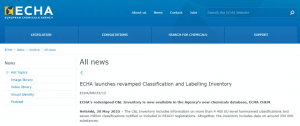
Data Upgrade
The C&L Inventory now contains data on approximately 350,000 substances, including more than 4,400 harmonised classifications established at the EU level and over 7 million industry classifications notified or included in REACH registrations.
User-Friendly Enhancements
This module upgrade marks a significant milestone in ECHA’s efforts to build a comprehensive chemical information system. Following the initial launch of ECHA CHEM in January 2024, the integration of the C&L Inventory represents a key step in consolidating existing datasets.The upgraded C&L Inventory brings three core improvements:
- Enhanced user interface for easier navigation and retrieval of classification data;
- Clearer presentation of current and upcoming EU harmonised classifications;
- Structured data format to support companies in implementing precise and compliant safety measures.
Looking Ahead
As the largest chemical database in the EU, ECHA CHEM plays a vital role in integrating data from industry submissions and regulatory oversight.
The platform aims to serve as a central hub for public access to chemical safety information, aligning with regulatory frameworks such as REACH and increasing transparency regarding ECHA’s decision-making processes.
Step-by-Step Guide: How to Search Classification Information
Step 1: Visit the ECHA CHEM websiteCheck the box for “I have read and I accept the legal notice.” Step 2: Enter the substance's CAS number, EC number, English name, or Index number into the search bar and click “Search.”
Step 2: Enter the substance's CAS number, EC number, English name, or Index number into the search bar and click “Search.”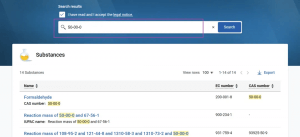 Step 3: From the search results (fuzzy match supported), click on the specific substance name — for example, “Formaldehyde” — to view its GHS classification.
Step 3: From the search results (fuzzy match supported), click on the specific substance name — for example, “Formaldehyde” — to view its GHS classification.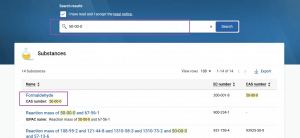 Step 4: On the substance profile page, select “Classification & labelling” from the left-hand menu. Two sub-sections will appear:
Step 4: On the substance profile page, select “Classification & labelling” from the left-hand menu. Two sub-sections will appear:
① CLP Annex VI – Harmonised classification
② Industry self-classifications Step 5: Click CLP Annex VI – Harmonised to view the EU harmonised classification.
Step 5: Click CLP Annex VI – Harmonised to view the EU harmonised classification.
If the classification varies by substance properties (e.g., state or form), the information will be displayed accordingly for each applicable variant.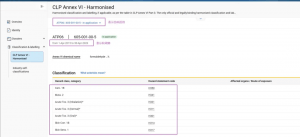 Note: This section also shows both current harmonised classifications and upcoming ones, along with their implementation dates.Step 6: Click Industry self-classification to view all self-classifications submitted by companies. The system displays the source and the latest update date for each classification, helping users assess the reliability and relevance of the data.
Note: This section also shows both current harmonised classifications and upcoming ones, along with their implementation dates.Step 6: Click Industry self-classification to view all self-classifications submitted by companies. The system displays the source and the latest update date for each classification, helping users assess the reliability and relevance of the data.
As shown below, 43 different self-classifications have been submitted for formaldehyde. The classification submitted by APT22 is marked as the most recommended based on ECHA’s algorithm.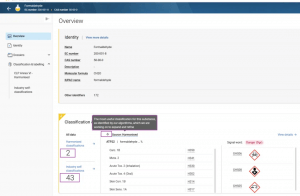
Key Notes
- Industry self-classifications are submitted by EU manufacturers and importers through REACH registrations and CLP notifications.
Submission priority is ranked as follows:
REACH Joint Submission > Joint Submission - Opt-out > Individual Submission > CLP Notification - ECHA uses a scoring algorithm to highlight the most useful classification for a substance from among many submissions. This recommendation is indicated with a star icon. The algorithm is continuously being improved.
ECHA will continue improving the platform's capabilities, including plans to integrate ECHA CHEM with external data systems through API interfaces.Note: The legacy C&L Inventory platform will remain available and regularly updated, but it does not include new hazard classes such as Endocrine Disruptors (ED), PBT/vPvB, or PMT/vPvM classifications.
Important Reminder for Companies
The new ECHA CHEM platform serves as a next-generation, integrated chemical data system developed by ECHA.When preparing EU-compliant Safety Data Sheets (SDS) and product labels, companies can consult this platform to verify classification data, track CLP ATP updates, and ensure timely hazard communication across the supply chain. This ultimately supports the implementation of proper worker safety measures.
Want to learn more?
Join ECHA’s webinar on the Classification & Labelling Inventory.





